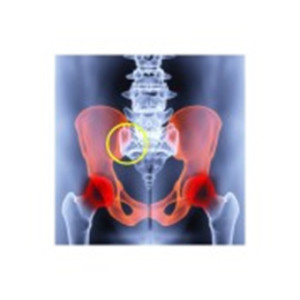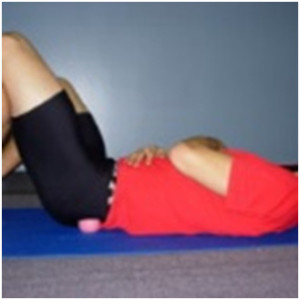You Can Enjoy Pain Free Living From Home
Author: Julie Donnelly, LMT –The Pain Relief Expert
Editor: Dr. Steve Chaney
I received a call from a distressed client about her son’s unbearable SI joint pain that refuses to hold a chiropractic adjustment. Her son has dealt with the pain for several years. His pain is beginning to turn his life into a bad dream since it’s prohibiting him from playing the sports he enjoys and he doesn’t see an end in sight. Maybe you can relate.
What Causes SI Joint Pain?
 The sacroiliac joint is the point where the sacrum (white area) and the ilium (red area) join together (circled in yellow).
The sacroiliac joint is the point where the sacrum (white area) and the ilium (red area) join together (circled in yellow).
When the muscles that surround the joint are either too tight or too loose, or if you have an accident, the joint can be pulled out of alignment.
This misalignment will cause pain in the immediate area, and also cause symptoms that are similar to low back pain and/or sciatica.
Imagine the overlapping area (circled in yellow) moving in a manner that separates the two bones…ouch! You can imagine how this not only strains the sacroiliac joint, but also causes a misalignment at the hip and pubic joint.
This can cause low back pain, SI joint pain, hip pain or groin pain. The pain can also refer down the leg and even into the foot.
Why Chiropractic Adjustments May Not Hold
We love chiropractors and the care they provide. Spinal health is essential for longevity and vitality.
Some adjustments may not hold, whether it’s an adjustment for SI joint pain, sciatica, back pain, shoulder pain, or anything else, because the muscles that pull the bones out of alignment in the first place aren’t being released prior to the adjustment. (When releasing a muscle you are releasing tiny muscle fiber knots that cause the muscle to shorten and pull on the bone.)
Think of this analogy, imagine you had a length of rope with a stick tied in the middle. As you pull one side of the rope to tug the stick in that direction in order to bring the stick back to the middle you have to first release the tug (tension) on the rope.
This is similar to what happens when adjustments are unable to hold. The tight muscle is pulling on the joint, the chiropractor pushes (adjusts) the joint back into place and then the tight muscle pulls it right back out again. This can go on and on until the muscle knots are released.
Get SI Joint Pain Relief with this Muscle Release Technique
 STEP 1: Place a Trigger Point Treatment Ball (or a firm tennis ball) directly on your SI joint.
STEP 1: Place a Trigger Point Treatment Ball (or a firm tennis ball) directly on your SI joint.
Ease your body down onto the ball gently. It’s important to stay in the “hurts so good” range; it may feel uncomfortable but not a sharp pain. If you feel a sharp pain, move the ball to a spot nearby, but not directly on the joint.
Move the ball around the entire area to release the tension (muscle knots) in all of the muscles. Stay on any tender points for about 30 seconds.
STEP 2: Once you feel you have released the tender areas (trigger points), place the ball directly on your SI joint. Bring your same-side leg up, resting your lower leg on the thigh of your opposite leg. (The same movement as crossing your leg in a chair.) The intention here is to add an additional stretch to the muscles surrounding your SI joint.
This muscle release technique may take a few times before the muscles completely relax and the SI joint is no longer being pulled out of alignment.
Now the next time you see your chiropractor you’ll get an adjustment that lasts! You may even find that this technique allows the joint to move back into alignment on its own.
Wishing you well,
Julie Donnelly
About The Author
Julie Donnelly is a Deep Muscle Massage Therapist with 20 years of experience specializing in the treatment of chronic joint pain and sports injuries. She has worked extensively with elite athletes and patients who have been unsuccessful at finding relief through the more conventional therapies.
She has been widely published, both on – and off – line, in magazines, newsletters, and newspapers around the country. She is also often chosen to speak at national conventions, medical schools, and health facilities nationwide.
These statements have not been evaluated by the Food and Drug Administration. This information is not intended to diagnose, treat, cure or prevent any disease.

